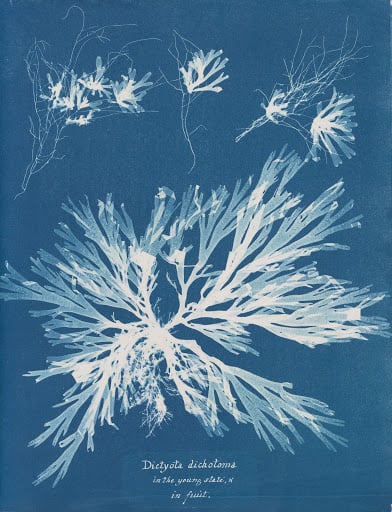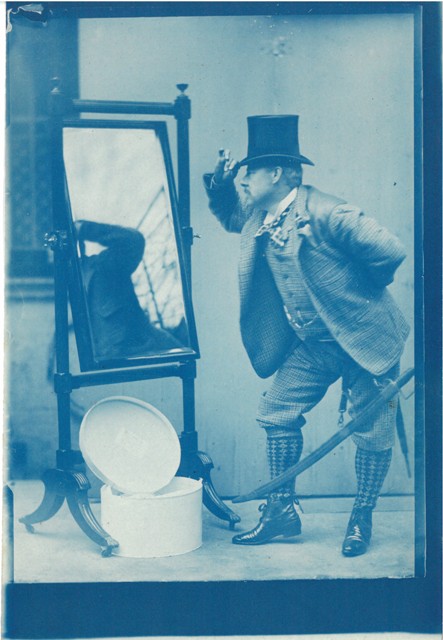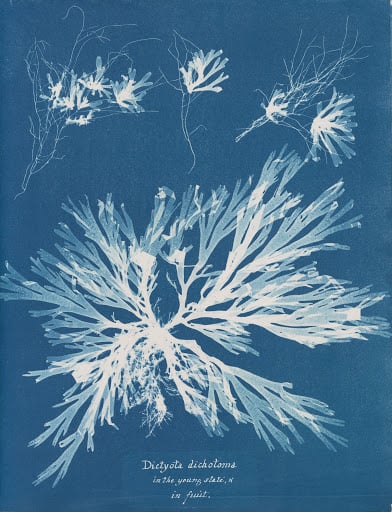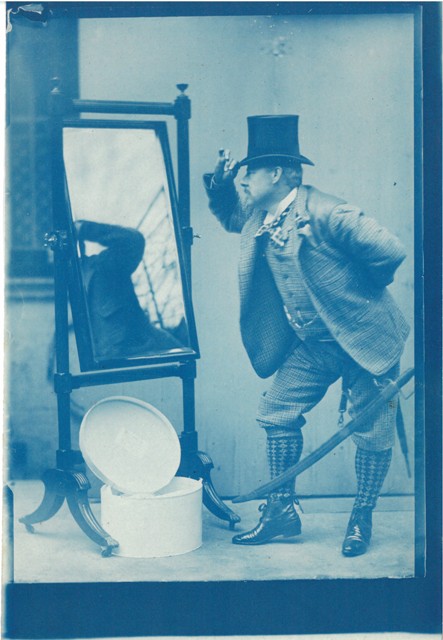La cianotipia è un genere di stampa a contatto che ha come caratteristica il colore blu (da qui il nome di blueprint), dal greco antico kýanos (blu), ed è stato inventato dallo scienziato J.W. Herschel alcuni anni dopo la nascita della fotografia (1842).
La caratteristica colorazione blu è dovuta alla combinazione del ferrocianuro di potassio con citrato ferrico ammoniacale che reagiscono alla luce del sole rendendo la superficie di un foglio di un intenso colore blu di Prussia.
Veniamo alla tecnica, utilizzata sia in fotografia che in grafica (quest’ultima almeno fino agli Settanta del secolo scorso).
Si applica l’emulsione di ferrocianuro di potassio e citrato ferrico ammoniacale su un foglio di carta. In tal modo il foglio diventa fotosensibile. Successivamente si poggia sul foglio un negativo, ma possono essere posti sopra il foglio anche dei fiori, oggetti o qualsiasi forma vogliate. Messo ben fermo il soggetto, si espone il foglio ai raggi solari per un tempo che varia da qualche minuto fino a una ventina circa. Il tempo di esposizione dipende dalla copertura del sole, quindi se il cielo è coperto da nuvole ci vorrà maggior tempo. Le parti del foglio esposte al sole, per reazione dell’emulsione, avranno il colore blu, mentre quelle nascoste ai raggi ultravioletti rimarranno bianche (in linea di massima è così, dipenda dall’oggetto posto sulla superficie). Successivamente viene eliminato il residuo di emulsione che non ha lasciato impronta dopo l’esposizione ai raggi del sole: si immerge il foglio in acqua e l’emulsione in eccesso, che non ha fatto reazione sul foglio, viene letteralmente lavata via. Si lascia asciugare e la stampa è stata completata.
Dopo l’asciugatura, si possono utilizzare dei metodi del tutto naturali, come l’aceto per esempio, per ottenere un colore blu un po’ più intenso. Oppure, utilizzando sempre dei prodotti naturali come il caffè o il tè, si può ottenere un viraggio del colore su tonalità del seppia o marrone.
Questa tecnica di stampa, facile da attuare e abbastanza economica, si può effettuare anche su altre superfici come il legno, i tessuti, il vetro, la ceramica. Questa sua versatilità l’ha resa una tecnica artistica vera e propria, sfruttata anche per opere di una certa grandezza: la più grande opera di blueprint realizzata è stata creata da Stefanos Tsakiris a Salonicco, in Grecia, il 18 settembre 2017 e misura ben 276,64 m².
Unica nota dolente è che non si possano fare degli ingrandimenti o negativi della stampa direttamente sull’emulsione a causa della bassa sensibilità dell’emulsione stessa: il rapporto con l’oggetto è di 1:1.
Anna Atkins fu la prima fotografa della storia e come altro primato le viene attribuito anche quello di aver stampato le sue fotografie di alghe con la tecnica della cianotipia. Il suo libro “Photographs of British Algae: Cyanotype Impressions” del 1843, è considerato il primo libro illustrato con immagini fotografiche con didascalie scritte a mano.
L’effetto della stampa blueprint richiama il mare e il cielo e trasmette una sensazione di profondità, di calma, equilibrio. La sensazione è quella di immergersi in uno scenario dai toni pacati che scava nelle profondità dell’anima. Introspezione nell’introspezione: dove la scelta del soggetto si mescola con quella del colore per esternare le proprie emozioni, la propria personalità. Il colore blu, per antonomasia il colore della quiete, dell’eleganza, intenso, misterioso. Chi ama il blu è solitamente una persona calma e coerente, che riflette prima di agire.
Adesso non ci resta che esternare il nostro spiraglio di blu e segnarlo definitivamente su una superficie attraverso la blueprint.


CYANOTYPE
Cyanotype is a type of contact printing which has the color blue as its characteristic (hence the name blueprint), from the ancient Greek kýanos (blue), and was invented by the scientist J.W. Herschel a few years after the birth of photography (1842).
The characteristic blue color is due to the combination of potassium ferrocyanide with ammoniacal ferric citrate which react to sunlight making the surface of a sheet of an intense Prussian blue colour.
We come to the technique, used both in photography and in graphics (the latter at least until the seventies of the last century).
The emulsion of potassium ferrocyanide and ammoniacal ferric citrate is applied to a sheet of paper. In this way the sheet becomes photosensitive. Subsequently, a negative is placed on the sheet, but flowers, objects or any shape you want can also be placed on top of the sheet. Having placed the subject firmly still, the sheet is exposed to the sun’s rays for a time that varies from a few minutes to about twenty. The exposure time depends on the sun’s coverage, so if the sky is covered by clouds it will take longer. The parts of the sheet exposed to the sun, due to the reaction of the emulsion, will have a blue colour, while those hidden from ultraviolet rays will remain white (in principle this is the case, depending on the object placed on the surface). Subsequently, the emulsion residue that has not left a mark after exposure to the sun’s rays is eliminated: the sheet is immersed in water and the excess emulsion, which has not reacted on the sheet, is literally washed away. Leave it to dry and the print is complete.
After drying, you can use completely natural methods, such as vinegar for example, to obtain a slightly more intense blue color. Or, always using natural products such as coffee or tea, you can obtain a color change to sepia or brown shades.
This printing technique, easy to implement and quite economical, can also be carried out on other surfaces such as wood, fabrics, glass, ceramic. This versatility has made it a real artistic technique, also exploited for works of a certain size: the largest blueprint work created was created by Stefanos Tsakiris in Thessaloniki, Greece, on 18 September 2017 and measures 276 .64 m².
Anna Atkins was the first photographer in history and as another record she is also credited with having printed her photographs of algae with the cyanotype technique. Her 1843 book “Photographs of British Algae: Cyanotype Impressions” is considered the first book illustrated with photographic images with handwritten captions.
The only sore point is that it is not possible to make enlargements or negatives of the print directly on the emulsion due to the low sensitivity of the emulsion itself: the relationship with the object is 1:1.
The effect of the blueprint print recalls the sea and the sky and transmits a sensation of depth, calm and balance. The sensation is that of immersing yourself in a scenario with calm tones that delves into the depths of the soul. Introspection within introspection: where the choice of subject mixes with that of color to express one’s emotions, one’s personality. The color blue, par excellence the color of quiet, elegance, intense, mysterious. Those who love blue are usually calm and coherent people who think before acting.
Now all we have to do is externalize our glimmer of blue and mark it definitively on a surface using the blueprint.

